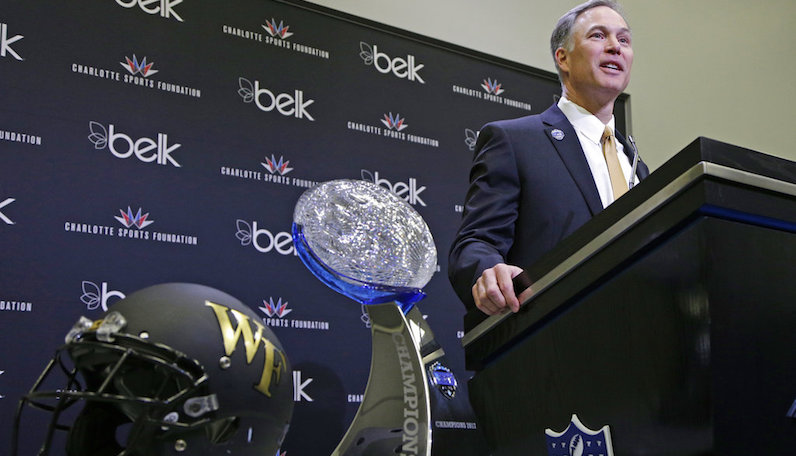Dave Clawson described Wake Forest’s first early signing period as drama-free: The Deacons sent out 21 letters and got 21 back.
In addition, the class was balanced — 10 players on each side of the ball and a kicker. It pulled from the same regions that the Deacons have been pulling, with an emphasis on South Carolina, Georgia and Florida.
But that doesn’t mean there aren’t a few things we can learn from what happened. Here are some observations:
The “new” signing day
Clawson and his staff clearly treated this as a replacement for the February signing day, feeling as though they should sign a full class. We previously outlined how the Deacons have about 21 scholarships to deal with. Clawson reiterated that the Deacons don’t oversign and wondered how many good players would be out there in February.
Wiggle room
However, Clawson did surprise by saying that he held on to “one or two” scholarships for February. Looking at the roster, we’re not exactly sure where those would come from, but there’s always some unexpected movement based on academics or a desire for playing time. As we noted before, it’s a smart move — especially as this first version of the new signing structure works itself out — to have some openings to take on players who maybe don’t get the love they expected from a bigger program.
Grayshirting
The most surprising comment from Clawson may have been his reference to grayshirting, which is when a school asks a player to wait until the next spring (2019, in this case) to enroll. It’s a practice the really Deacons haven’t used, although they did have Tayvon Bowers on that path because of his knee injury, but his recovery went well enough that he enrolled last fall and redshirted.
Clawson said: “There’s a chance, and we have told the players, that a handful could possibly be grayshirts. We tell them that before the fact.” Those comments seem to go a bit against Clawson’s comments about not oversigning, although it’s a subtle difference.
This doesn’t seem to be something that goes with the Wake Forest approach, and it seems like a school would get a reputation if it used grayshirting very often. So we’d be surprised if the Deacons used this strategy for anything but to clear space for a very high-level recruit.
Confidence
With each recruiting class, Clawson and his staff seem more and more comfortable landing players who aren’t on the recruiting radar. Almost a third of this year’s class saw very little attention from Power Five schools. But the staff has been buoyed by recent successes with under-the-radar recruits, such as three of his starting linemen (Jake Benzinger, Phil Haynes and Ryan Anderson) and this year’s sensation, Greg Dortch.
“I think every year we’ve learned to recruit better for Wake Forest and done a better job every year of getting guys that fit our school and fit our campus and fit our community,” Clawson said. Previous Wake Forest coaches can report that it’s difficult to survive recruiting on that thin line all the time, and time will tell if this staff continues to identify the right players.
Early enrollees
The Deacons will have the most players enroll in the spring during Clawson’s era, six: defensive lineman Kelijiha Brown, defensive backs Nasir Greer and Zion Keith, offensive lineman Michael Jurgens, tight end Blake Whiteheart and quarterback Sam Hartman.
Of the group, those with the best chance to play early are Brown, as he’s one of the top players in the class and the Deacons might need inside depth next season; and the defensive backs, as that’s been a thin spot recently. However, if any DBs play, it’s more likely to be Kenneth Dicks or Peyton Woulard, both of whom had a number of ACC and other Power Five offers.
Read More
Pick you poison: Bryant Crawford pushes the pedal for Wake Forest’s PNR Machine

















